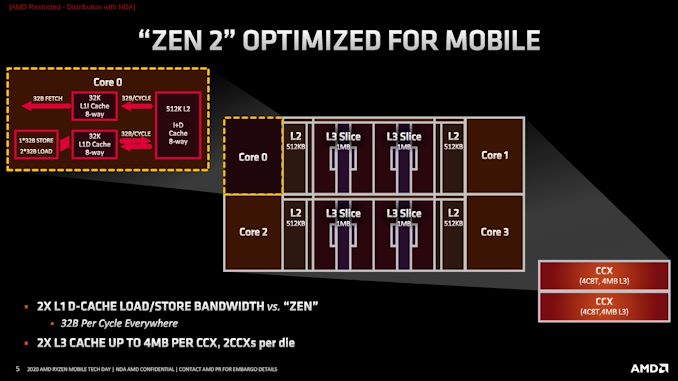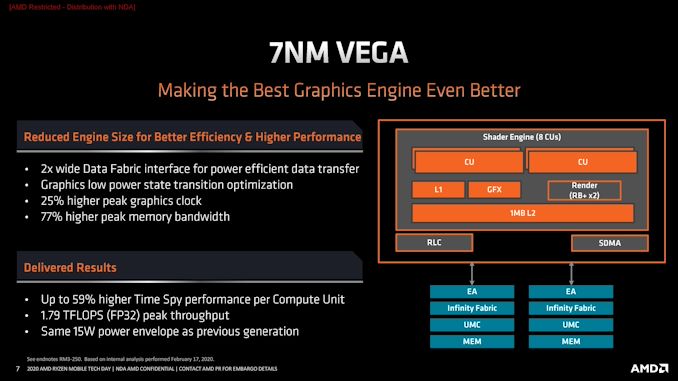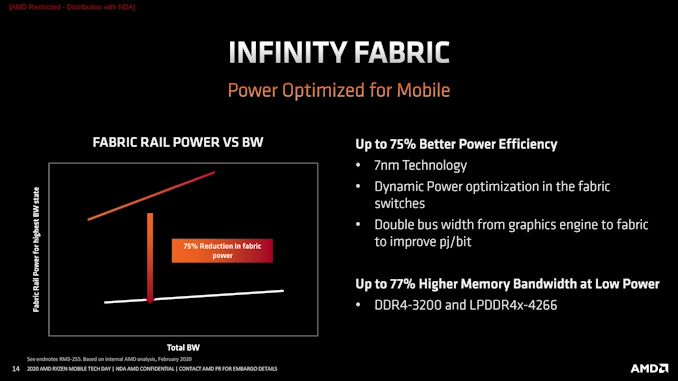AMD Details Renoir: The Ryzen Mobile 4000 Series 7nm APU Uncovered
by Dr. Ian Cutress on March 16, 2020 11:00 AM ESTWhat’s New
AMD’s latest Ryzen mobile product is the first design the company has done that combines CPU, GPU, and IO all on a monolithic die in TSMC’s 7nm process.
The CPU part of the design is very similar to what we’ve seen on the desktop: two quad core groups each with their own L3 cache shared between the cores. Compared to the desktop design, the mobile is listed as being ‘optimized for mobile’, primarily by the smaller L3 cache – only 4 MB per quad-core group, rather than the 32 MB per quad-core group we see on the desktop. While the smaller L3 cache might mean more trips out to main memory to get data, overall AMD sees it as saving both power and die area, with this level of cache being the right balance for a power limited chip.
Compared to the previous generation of Zen mobile processors, this generation on the CPU side of the equation comes with the 15% per-core iso-frequency improvement, down to the improvements at the heart of each core. We’ve covered these in detail in our desktop analysis. However for the mobile platform, not only is there a raw performance uplift, but we’re also seeing frequency uplift as well, moving from 4.0 GHz in the prior gen up to 4.3 GHz here. Actual workload performance AMD says gets a significant uplift due to the new power features we’ll discuss in due course.
On the GPU side is where we see bigger changes. AMD does two significant things here – it has reduced the maximum number of graphics compute units from 11 to 8, but also claims a +59% improvement in graphics performance per compute unit despite using the same Vega graphics architecture as in the prior generation. Overall, AMD says, this affords a peak compute throughput of 1.79 TFLOPS (FP32), up from 1.41 TFLOPS (FP32) on the previous generation, or a +27% increase overall.
AMD manages to improve the raw performance per compute unit through a number of changes to the design of the APU. Some of this is down to using 7nm, but some is down to design decisions, but it also requires a lot of work on the physical implementation side.
For example, the 25% higher peak graphics frequency (up from 1400 MHz to 1750 MHz) comes down a lot to physical implementation of the compute units. Part of the performance uplift is also due to memory bandwidth – the new Renoir design can support LPDDR4X-4266 at 68.3 GB/s, compared to DDR4-2400 at 38.4 GB/s. Most GPU designs need more memory bandwidth, especially APUs, so this will help drastically on that front.
There are also improvements in the data fabric. For GPUs, the data fabric is twice as wide, allowing for less overhead when bulk transferring data into the compute units. This technically increases idle power a little bit compared the previous design, however the move to 7nm easily takes that onboard. With less power overhead for bulk transfer data, this makes more power available to the GPU cores, which in turn means they can run at a higher frequency.
Coming to the Infinity Fabric, AMD has made significant power improvements here. One of the main ones is decoupling the frequency of Infinity Fabric from the frequency of the memory – AMD was able to do this because of the monolithic design, whereas in the chiplet design of the desktop processors, the fix between the two values has to be in place otherwise more die area would be needed to transverse the variable clock rates. This is also primarily the reason we’re not seeing chiplet based APUs at this time. However, the decoupling means that the IF can idle at a much lower frequency, saving power, or adjust to a relevant frequency to mix power and performance when under load.
Again we see the double bus width from the graphics to the engine pop up here, giving a better power-per-bit metric. But one of the key aspects from this graph is showing that the power consumed by the fabric in the new processors is very even across a wide bandwidth range compared to the older processor, where the voltages likely had to be stepped up as bandwidth increased, and introducing additional latency factors for performance. Luckily Renoir does away with this, and AMD are claiming a 75% better fabric efficiency compared to the previous generation.
Orthogonal to the raw improvements, AMD has also improved the media capabilities, with a new HDR/WCG encode engine for HEVC, which according to AMD should give a 31% encoding speedup when used.














95 Comments
View All Comments
Cooe - Friday, April 23, 2021 - link
Delusional idiot alert. Because creating super expensive HEDT pin-out sized bespoke sockets solely for low-mid end market desktop APU's definitely makes ANY kind of sense... -_-lisabmassey - Wednesday, March 25, 2020 - link
Make 6150 bucks every month... Start doing online computer-based work through our website. I have been working from home for 4 years now and I love it. I don't have a boss standing over my shoulder and I make my own hours. The tips below are very informative and anyone currently working from home or planning to in the future could use this website... WWW.iⅭash68.ⅭOⅯsuperflex - Thursday, May 21, 2020 - link
Do you have to swallow for $6150RamIt - Monday, March 16, 2020 - link
Looking forward for a test unit. Battery life and mild gaming may make me shift to AMD.EliteRetard - Monday, March 16, 2020 - link
I think a 48-4900 HS without a GPU would be the perfect laptop for most people.I've been wishing for something like this for a very long time.
High core count and TDP for real work, with enough IGP for casual gaming. Still lower power than a 45w chip, especially since they're always paired with at least a 25w GPU (even though most don't need it).
U series for those who care about battery above all else, HS + IGP for the vast majority, and H + DGPU for gamers and mobile workstations.
Please make it so!
deksman2 - Monday, March 16, 2020 - link
Actually, I'd prefer they give the APU full 45W TDP 'breathing room', otherwise it will 'choke' on the 35W TDP constraints.Most laptop OEM's don't really pay too much attention in designing adequate cooling systems for their designs, which can lead to thermal throttling, overheating and performance losses.
I'd rather they work with the 'maximum allowed TDP' for the chip (say 45W) design a cooling system that's more than enough to handle it and work from there.
I'd prefer seeing 4900H with a decent dGPU such as RX 5700M and proper cooling design to produce limited noise under full load and that both CPU/IGP and dGPU can reach/sustain their maximum advertised performance indefinitely (or for as long as one needs them).
I need productivity on the go, and I have no time for cooling shenanigans from OEM's.
EliteRetard - Monday, March 16, 2020 - link
35w gives tons of "breathing room", it's over twice the TDP of U series parts.It's also half the power of a 45w CPU plus low end 25w DGPU.
I fully expect it'll maintain a good 3+GHz under full load (vs 2GHz for U series).
For cooling, OEMs can just slap on the cooler from their 45w designs.
The vast majority of people don't need a DGPU, but they are currently forced to buy one if they want any performance CPU. That costs them more money, increases weight, and reduces battery life (two fold, less space for battery and higher draw).
You obviously want a gaming laptop, and that's not at all what I'm discussing.
80% of the market would be incredibly well served with a 35w HS APU.
Far better than the crappy U series they've been forced into.
For the 10% who want battery life over anything, they can get a 15w U series.
For the 10% who want max gaming they can get a 45w H series.
I've been begging for a logical laptop for so long... I seriously can't understand why OEMs have refused to even consider it. In what other industry do manufactures refuse to service the needs of 80% to cater only for the odd 20%? "Oh you want something practical? HA screw you!"
Imagine if you could only buy a 2 seat scooter for $15+k, or a massive 4 door 8ft bed truck for $100+k. And there are literally no other options, new or used...there has been only these two choices being sold by every car maker in the entire world. If you want to do anything more than a scooter can handle, you are literally forced to buy a massive overkill option no matter how impractical.
That's literally how the laptop market has been for almost a decade.
wolfesteinabhi - Tuesday, March 17, 2020 - link
i totally see where you are going with this ...but for vast majority .. people dont care about CPU's and performance ... all they ask is a cheap laptop with good battery life....they dont even compare or ask for model numbers for CPUs .... they jsut see its as core i3 or core i5 ... or Ryzen 3/5 .. thats all they "perceive" as performance..... and lastly they want it dirt cheap. (also they expect to have a dGPU to always out perform iGPU ....even if dGPU is pants like MX150)erple2 - Wednesday, March 18, 2020 - link
Frankly, the 4800 is much more capable than what most people need in a laptop. I've seen people effectively develop applications on an Atom based Chromebook with great success, and based on what I see other people that aren't enthusiasts doing, even the bottom tier 4600H is more than they need. It's exceedingly rare for any normal user to need more than even 4 cores to do their normal workload of opening tabs, checking email, talking on videochat.Namisecond - Thursday, March 26, 2020 - link
I agree, for general computing tasks, 4 cores or 4 fully powered threads is good enough for most people. In a laptop, for a lot of people, the important factors are: size/weight, screen quality, battery life, design aesthetics, not necessarily in that order.I used to buy thin-and-light gaming laptops for my own perceived needs...but recently, I've found that I'm carrying the atom-powered thin and light, because the screen is good enough, the size and weight is good, and it has all-day battery life.